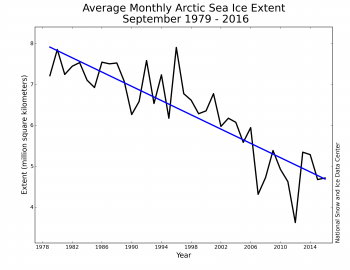The decline of Arctic ice didn’t set a record this year, with sea ice extent coming in eigth after record-setting 2012. On September 13, at the summer minimum, sea ice covered 4.64 million square kilometers; that’s 1.25 million square kilometers more than 2012.*
However, that fact was overshadowed by another: experts say what matters most in the Arctic is the total volume of ice — a combination of thickness and extent. 2017 saw summer volumes among the lowest ever recorded.
The Arctic set still another record that concerns scientists: no other 12-month period (September 2016 to August 2017) has had such persistently low sea ice extent.
The Arctic ice is therefore showing no signs of recovery, scientists say, and its decline is likely continuing to impact the Earth’s weather in unpredictable and destabilizing ways.
http://neven1.typepad.com/
*The numbers are the ice extent in millions of square kilometers on the day of ice minimum. This metric can vary enormously from day to day as wind and current blow floating pack ice around, both compacting and dispersing it. A more meaningful statistic is the ice extent averaged for the entire month of September, compared to previous Septembers. This value will be published within the next few days by NSIDC, and I will post it here when it is available.
In the meantime, just to whet your appetite, here is the graph for averaged September ice extents from 1979 to 2016, minus the 2017 Sept extent number. As you can see, we have once again avoided the catastrophic melt-downs we experienced in 2007 and 2012, but the trend is still down, along the blue regression line.

https://nsidc.org/arcticseaicenews/files/2016/10/monthly_ice_09_NH-350×270.png